skip to main |
skip to sidebar
A steam engine needs a 'working fluid' to move heat from where it is generated (by the combustion of a suitable fuel) to where it is converted into mechanical energy. Water is boiled to make steam which readily flows to where it is converted into mechanical energy, usually in a reciprocating cylinder. Hence, a railway locomotive must carry water as well as fuel.
In England, steam locomotives were normally identified by counting wheels using Whyte's Notation. For instance '4-6-2' means four leading carrying wheels, six coupled wheels providing traction and two trailing carrying wheels. The English were never seduced by the equally reasonable idea of counting axles until the widespread adoption of diesel and electric traction, although Bullied called his 'Merchant Navy' Pacifics the '2 1 C' class.
If no qualifying letter was appended, it was assumed that there was a tender to carry the required water and fuel so, for instance, '0-6-0' implied a six-coupled locomotive with a tender.
It was convenient to produce designs omitting a tender for shunting or shorter distance working but this meant that the water tank had to be carried on the engine frames, together with the necessary fuel. The suffix 'T' is used to indicate 'Tank' and we call such engines 'Tank Engines'. In Germany, the term 'Tenderlok' is used for designs without a tender.
Early tank engines often carried water in a tank squeezed between the frames, underneath the boiler, rather limiting water capacity but early designers were very wary of raising the centre of gravity. I've driven an 1874 industrial six-coupled locomotive like this called 'Bellerophon' (not to be confused with the L.M.S, 'Jubilee' 4-6-0 of the 1930s). By providing outside cylinders and outside Gooch motion, a reasonable size water tank was included. A 'W' is often added to the designation to indicate 'Well Tank' so 'Bellerophon' is an 0-6-0WT.
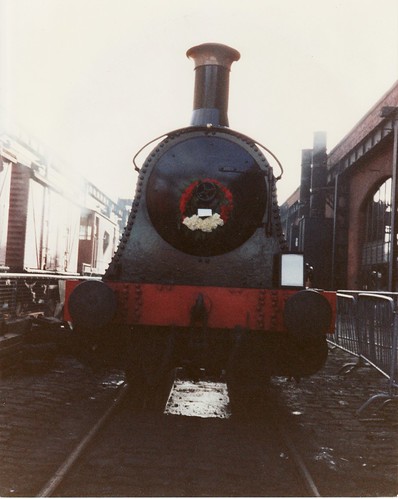
Visiting locomotive 'Bellerophon' at Manchester Museum of Science and Industry, carrying smokebox wreath and explanatory notice on the bufferbeam, commemorating the death of Mick Todd who was closely associated with the restoration of the locomotive.
Beattie designed a 2-4-0WT. I've driven both survivors. He somehow crammed inside motion (Stephenson Link, if I remember correctly) in front of the water tank, severely restricting capacity, so the lower part of the coal bunker is an extra water tank. I've written a post about these delightful engines here.
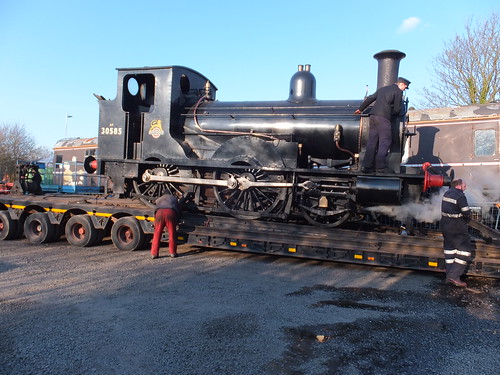 30585, still in steam, is chained in position on the low loader.
30585, still in steam, is chained in position on the low loader.
The 'saddle tank' was widely used, the name suggested by the curved shape of the tank placed on top of the boiler barrel, used particularly in small four-coupled engines like 'Henry' described here. An 'S' is often added to the designation. Saddle tanks are also used on larger 6-coupled locomotives like 0-6-0ST 'Sapper', described here. At least there's some space between the foot-framing (running plate) and the bottom of the tank to perform oiling and inspection. The disadvantage is that the water tank construction is complicated by the need to allow the chimney, dome and safety valves to pierce the tank, unless the tank is shortened to avoid either the chimney or safety valves.
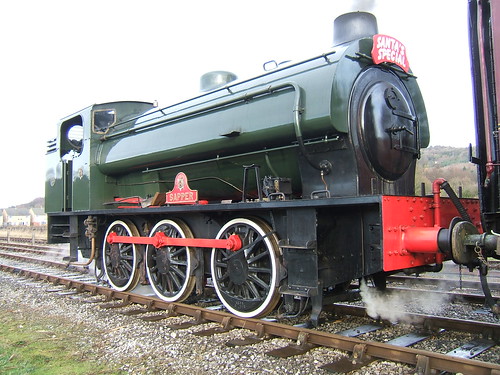 0-6-0ST 'Sapper'.
0-6-0ST 'Sapper'.
Carrying water in two flat tanks either side of the boiler then became a common practice. No extra letter was allocated so, for instance, 'Thomas the Tank' remains simply an 0-6-0T. I've driven a number of side tank locomotives (including a few posing as 'Thomas'). When you prepare a side tank with inside motion (which most British engines had), you quickly find the big disadvantage - access to the motion becomes very difficult, encouraging not-very-ladylike language.
 47298, posing as 'Thomas' shows her classic Midland lines and an odd paint job.
47298, posing as 'Thomas' shows her classic Midland lines and an odd paint job.
My posts on various 'Thomas' locomotives, all side tanks, are here.
The Great Western Railway used side tanks on its larger tank engines - this arrangement probably allows the largest water capacity.
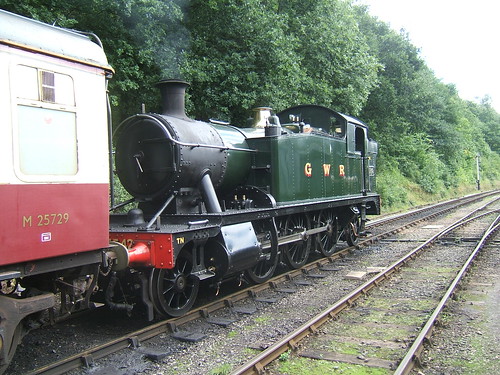 'Light Prairie' 5542 ready to depart from Shackerstone on the Battlefield Line.
'Light Prairie' 5542 ready to depart from Shackerstone on the Battlefield Line.
I'm afraid Britain was very slow to adopt a layout with two outside cylinders and outside Walschaerts motion, which eliminates the problem of access to the motion and allows full-length side tanks, although I've driven at least one such 0-4-0T - 'Cadbury No. 1' built by Avonside which worked at the Bournville chocolate factory.
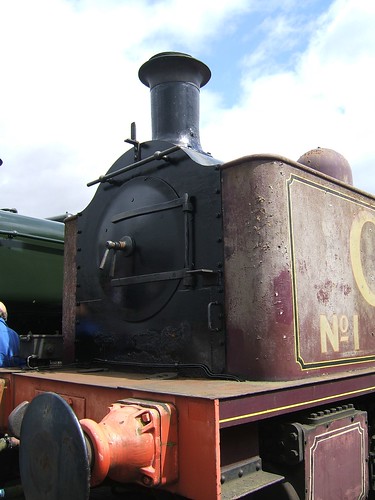
'Cadbury No. 1' has outside cylinders and Walschaerts motion, allowing full-length side tanks. The engine is currently out of traffic.
For their smaller tank engines, the Great Western Railway came up with a tank layout which allowed improved access to inside Stephenson Link Motion. Their solution has much to commend it - they used two 'pannier' water tanks allowing access to inside motion but leaving the top of the boiler unencumbered. A letter 'P' is often added to the designation. I've driven six or seven different 'Pannier' 0-6-0PT but not written a lot about these engines. These are capable, versatile engines and, as my friend John likes to remind me (after I used the phrase on a railway video) "You can do anything with a Pannier". There are some pictures of one example (5786) here. There are pictures of a later version (9466) which, remarkably was not built until 1952, here. I think Belgium was one of the few other countries which used the 'pannier' principle.
 Pannier tank 5786 'on shed' at Shackerstone.
Pannier tank 5786 'on shed' at Shackerstone.
Perversely, when the Great Western Railway did use Walschaerts motion (on the 4-cylinder express engines) they put it between the frames making access even worse than with link motion - just try oiling a 'Castle' or a 'King'. But valve motions are another story.
The Post Title
"Water, water, every where" is a line from The Rime of the Ancient Mariner by Samuel Taylor Coleridge.
On Sunday, 12th April 2015, Pathfinder Tours (2006) Ltd organised a Midlands rail tour, hauled by a pair of Class 20 from Direct Rail Services. Their advertising material said:-
No not a Trumpton tour but to locations in the Derwent Valley - an intriguing ramble around unusual lines in the Midlands, headed by English built locomotive types that are still giving sterling service over fifty years since built. With plenty of non-passenger line coverage we hope this Midlands perambulation will appeal to you. The on board catering will include both a buffet service, real ales and the Gricers Grill (with 'Roastie' option). MOTIVE POWER IS EXPECTED TO BE DRS CLASS 20 DIESEL LOCOMOTIVES WITH A DRS CLASS 37 ASSISTING IN THE MORNING BETWEEN DUDLEY RUN ROUND SIDING AND BROMSGROVE. Pick up stations: Crewe, Stafford & Walsall.
N.B. Trumpton’s fire brigade roll was :Pugh, Pugh, Barney McGrew, Cuthbert, Dibble and Grub.
Well, the Trumpton allusions were lost on me, but help was at hand in the Trumpton article on Wikipedia.
This railtour was ending up at Rowsley on Peak Rail and I was rostered as steam driver on the Peak Rail service. As usual, we were top-and-tailing with 'Lord Phil' on the south end of the train. The timetable was amended so that the Peak Rail train was waiting in the Up Platform at Darley Dale, allowing the 'special' to pass us using the Down platform on its way to Rowsley.
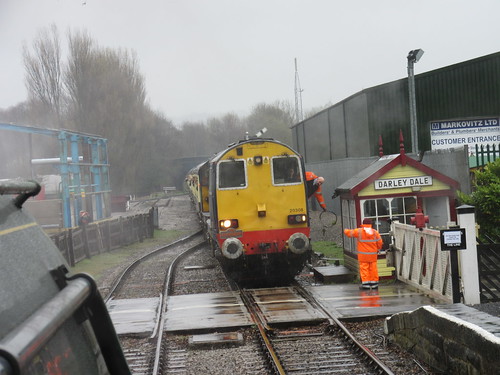 Peak Rail, 2015: The Pathfinder Railtour passing Darley Dale en route to Rowsley. Jack, the Peak Rail Conductor, surrenders the Matlock-Darley Dale token to the Darley Dale Signalman.
Peak Rail, 2015: The Pathfinder Railtour passing Darley Dale en route to Rowsley. Jack, the Peak Rail Conductor, surrenders the Matlock-Darley Dale token to the Darley Dale Signalman.
We then proceeded to Matlock Town, returned to Darley Dale and stood in the Down platform. Meanwhile, the pair of Class 20 had run round the train at Rowsley and returned to Darley Dale, stopping in the Up platform. The railtour had to wait for the 'road', giving us a chance to chat to the Direct Rail Services driver before we continued to Rowsley.

Peak Rail, 2015: The returning Pathfinder Railtour arriving at Darley Dale.
Direct Rail Services:
I hadn't realised until I wrote the post Furness and the Cumbrian Coast (Part 1) that Direct Rail Services was owned by the Nuclear Decommissioning Authority which is an Executive Non-Departmental Public Body (NDPB) reporting to the Department of Energy and Climate Change. Originally, it solely operated nuclear flask trains, but its work has now expanded and you can find out more here.
Other Railtours at Peak Rail
There have been a number of Railtours to Rowsley, some of which I've described in this blog:-
Steam Charter to Peak Rail.
The 'Peak Forester'.
HST Charter to Peak Rail.
My pictures of the Dimple, Darley and Dale
Peak Rail 2015 (part of album).
Brewood Garden Party took place at Brewood Hall on the 11th July 2015. This event was held at Brewood Hall for the first time in 2013 (there's a report here) and was repeated the following year (report here). The first two years had been blessed with hot, sunny weather and I'm pleased to report that the 2015 event enjoyed similar conditions.
Setting up
On the evening of the day before the Garden Party, a large number of Scouts and Scout leaders arrived to unload the various vehicles and trailers bringing the materiel needed, erect the various tents and sort the equipment ready for the final preparations on Saturday morning.
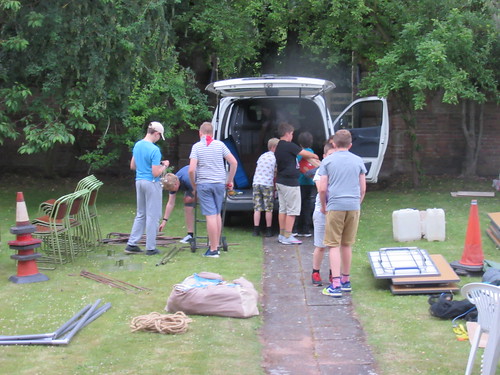 Unloading the first of many deliveries of equipment needed for the garden party.
Unloading the first of many deliveries of equipment needed for the garden party.
The volunteers worked quite late. As previously, two large modern frame tents were erected as the refreshment area and a similar tent was set up for games and stalls. The most demanding task was erecting the large canvas marquee which required good teamwork.
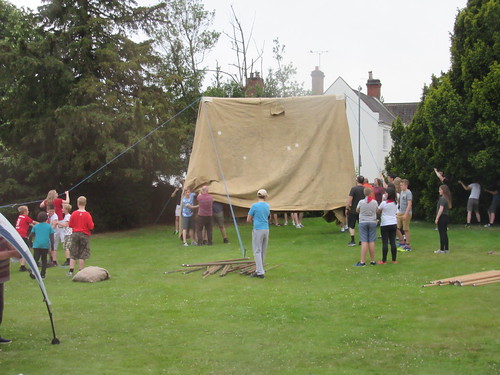 Erecting the large marquee.
Erecting the large marquee.
There was also a 'gazebo' tent and a futuristic-looking Coleman Event Shelter (I didn't know the Coleman brand but there's quite a nice video illustrating the history of the Company here. After watching the video, the 'Back Button' will return you to this post).
On Saturday morning, volunteers arrived to complete the setting-up, ready for the opening to the public at 1.00 p.m.
The Garden Party
By the time all was ready to admit visitors, a small queue had formed outside the entrance gates.
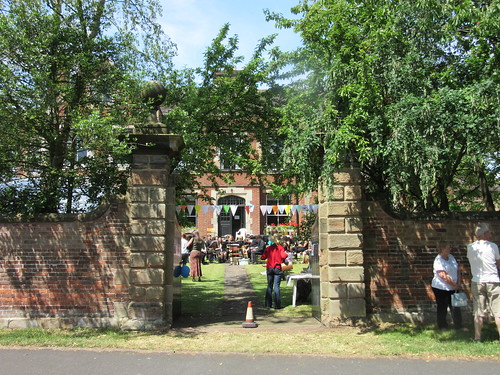 The entrance gates, viewed from the road.
The entrance gates, viewed from the road.
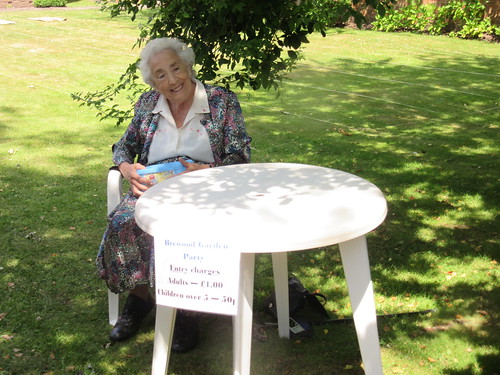 My friend Rita manned the Admission Table.
My friend Rita manned the Admission Table.
Marilyn Coulter from the parish church performed the official opening (before dashing back to St. Mary's and St. Chad's to perform a wedding, after which she returned to the garden party). A popular innovation this year was live music performed by two bands from the Cannock Performing Arts Centre:-
The 'Wind Band' at 1.15 p.m.
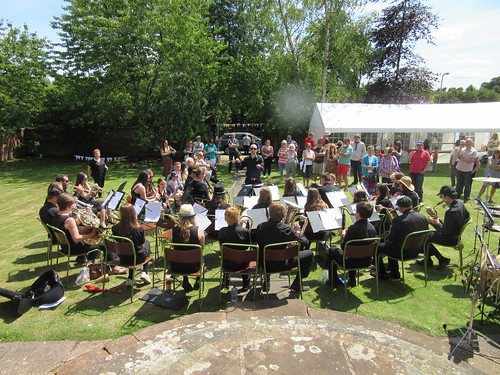 Cannock Performing Arts Centre 'Wind Band'.
Cannock Performing Arts Centre 'Wind Band'.
The 'Big Band' at 2.30 p.m.
 Cannock Performing Arts Centre 'Big Band'.
Cannock Performing Arts Centre 'Big Band'.
There's also a short video of the 'Big Band' here. After watching the video, the 'Back Button' will return you to this post.
Both bands are supported by the Friends of Cannock Performing Arts Centre who manned a stand.
 Friends of Cannock Performing Arts Centre - 'Supporting young musicians'.
Friends of Cannock Performing Arts Centre - 'Supporting young musicians'.
The P.D.S.A. and the Staffordshire Corps of Drums manned stands. 'The Trading Post' (which is Brewood Scouts own charity shop in Brewood) moved some of their stock to a stall at the garden party and the volunteers were kept busy. The large marquee hosted a number of craft stalls, a sweet shop and the judging for the cake-making contest. The refreshment tent was, as always, popular. The good weather encouraged many visitors to sit at the tables which had been provided outside the tent.
 The refreshment tent.
The refreshment tent.
Various games were laid on. The wet sponge throwing at a human target was always busy, as was the Coconut Shy.
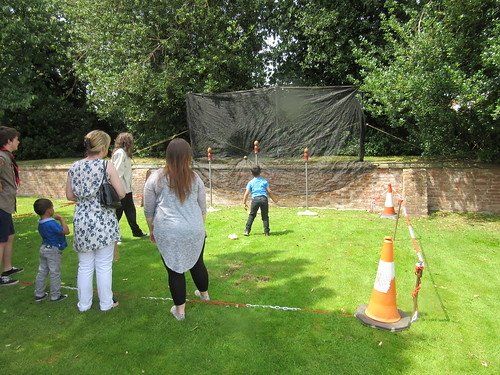 The Coconut Shy.
The Coconut Shy.
Another traditional entertainment for younger visitors was provided by a series of Sack Races and Egg and Spoon Races. These proved very popular.
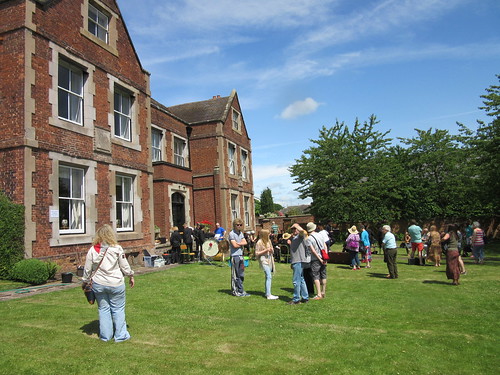 Visitors were able to enjoy the location and the sun.
Visitors were able to enjoy the location and the sun.
Everybody seemed to enjoy their visit and useful funds were generated which, this year, were divided between Brewood Scouts and the Jan Ford Foundation (supporting educational and medical charitable work in Myanmar).
Related posts on this site
Brewood Vintage Garden Party 2013.
Brewood Vintage Garden Party 2014.
More information on the charitable work supported by the Jan Ford Foundation in Myanmar (formerly Burma) can be found:-
Education Support
Medical Support.
Pictures of the event
Brewood Garden Party 2015

 30585, still in steam, is chained in position on the low loader.
30585, still in steam, is chained in position on the low loader.
 0-6-0ST 'Sapper'.
0-6-0ST 'Sapper'.
 47298, posing as 'Thomas' shows her classic Midland lines and an odd paint job.
47298, posing as 'Thomas' shows her classic Midland lines and an odd paint job.
 'Light Prairie' 5542 ready to depart from Shackerstone on the Battlefield Line.
'Light Prairie' 5542 ready to depart from Shackerstone on the Battlefield Line.

 Pannier tank 5786 'on shed' at Shackerstone.
Pannier tank 5786 'on shed' at Shackerstone.












